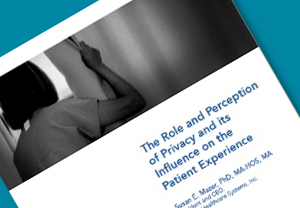This website uses cookies so that we can provide you with the best user experience possible. Cookie information is stored in your browser and performs functions such as recognising you when you return to our website and helping our team to understand which sections of the website you find most interesting and useful.
The Role and Perception of Privacy and its Influence on the Patient Experience
by Susan E. Mazer, Ph.D.
Published by the Beryl Institute, 2011
Introduction
Patient privacy has long held a unique place in medical events for families and physicians as codified in the Hippocratic Oath. However, there is a substantial distance between the original oath of confidentiality and current practices.
Considering how we normally use the term, “privacy”is relatively rare in a hospital. There are nurses’ stations, active hallways, patient rooms with doors that are seldom closed and public waiting areas where everyone who is there sees and hears everyone else. Furthermore, these waiting areas are designated by the procedure that is occurring (diagnostics, radiology, endoscopy, outpatient surgery, cardiology, etc.), immediately publicly disclosing the health issue that is at stake.
Yet, while a hospitalization occurs in a public institutional setting, the experience of illness and disease lives in the private domain of the patient. Those that care for patients are privy only to the pieces of the patient’s experience that are revealed in carefully constructed exchanges that attempt to capture how pain feels, how much pain is tolerable, how comfortable or uncomfortable the room, bed, bathroom are. It is ultimately the boundaries between the patient and everyone else, whether physical, social or emotional that define the space called privacy.
>>>Open PDF











